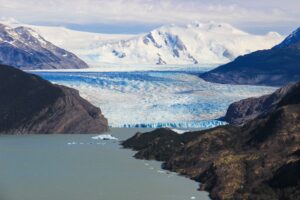Physical Address
23,24,25 & 26, 2nd Floor, Software Technology Park India, Opp: Garware Stadium,MIDC, Chikalthana, Aurangabad, Maharashtra – 431001 India
Physical Address
23,24,25 & 26, 2nd Floor, Software Technology Park India, Opp: Garware Stadium,MIDC, Chikalthana, Aurangabad, Maharashtra – 431001 India

By: Suja Mary James
CLAIM:
Increasing CO2 concentrations is known to increase the global temperature, especially over the poles, but the temperature over Antarctica is not getting warmer.
FACT:
Overall, the Antarctic region shows a warming trend. But the rate at which it is warming varies. For instance, much of West Antarctica is rapidly warming while the east side of the ice sheet is either not warmed at all in recent decades or has gotten slightly cooler.
WHAT THEY SAY:
“The Daily Sceptic” published an article titled “Scientists Struggle to Understand Why Antarctica Hasn’t Warmed for Over 70 Years Despite Rise in CO2” on 29th January 2023. We came across Twitter posts that have shared the article claiming that Antarctica hasn’t seen a rise in temperatures.
WHAT WE FOUND:
The impact of global warming due to the steady rise in CO2 has affected every inch of the Earth, and Antarctica is no exception. Reports claim that Antarctica has recorded a cooling trend but this is confined to the East Antarctic Ice Sheet while the Antarctic Peninsula has been experiencing warmer temperatures.
About Antarctica
Antarctica, the fifth-largest continent, covering 5.4 million square miles (14 million square km) has an average winter temperature of −81°F (−63°C) and reaches −128.6°F (−89.2°C). About 98% of the continent is covered by a glacial ice sheet that extends almost 14 million square kilometres (5.4 million square miles). The total volume of ice in Antarctica is about 7.2 million cubic miles (30 million cubic km), comprising about 90% of the world’s ice and about 70% of the world’s fresh water. The average height of the ice sheet is approximately 10,000 ft above sea level. At its thickest point, the ice is 15,700 ft (4776 m) thick. The East Antarctic Ice Sheet is by far the biggest ice sheet, making up 92% of the total glacial ice, while the West Antarctic Ice Sheet makes up only about 8%.
Climate Change and Antarctica
The IPCC Sixth Assessment Report states that since the mid-20th century, human activity has been the primary cause of global climate change. Antarctica and the Southern Ocean play an integral role in predicting the future of Earth’s climate system. Over the past 50 years, the west coast of the Antarctic Peninsula – one of the most rapidly warming places in the Southern Hemisphere, has seen average summer temperatures increasing by over 5°F (3°C) between 1970 and 2020, five times the global mean. This warming is not restricted to the land but to the Southern Ocean as well. There are signs that the temperature is rising more slowly across the rest of Antarctica. Also, the Antarctic Circumpolar Current is currently known to warm faster than the world’s oceans as a whole.
Antarctica’s physical and livable environment is changing as a result of the Antarctic Peninsula’s warming. Because of the shifting sea ice conditions, penguin colony distribution has shifted. Plant colonization has risen as a result of the melting of perennial snow and ice covers. Reduced sea ice cover may be linked to a long-term drop in the Antarctic krill population in the SW Atlantic region of the Southern Ocean. In recent years, it has been noted that numerous glaciers have retreated and that ice shelves that once surrounded the Peninsula have also receded, with some even collapsing entirely.
Signs of Warming
Why Contradictory Cooling?
East Antarctica had a marked cooling trend throughout the austral summer, despite West Antarctica having the most noticeable global warming. This cooling is linked to high-latitude atmospheric dynamics, stratospheric ozone change, tropical sea surface temperature anomalies and decadal changes in the Madden-Julian oscillation (MJO)
A study published on www.science.org demonstrated that the decadal variations of the Madden-Julian oscillation were responsible for up to 20 to 40 per cent of the observed summer cooling trend in East Antarctica (MJO). Both observational analysis and climate model experiments show that the decadal variations in the MJO, which have been characterized by less (more) atmospheric deep convection in the western Pacific (Indian Ocean) over the past two decades, have contributed to the net cooling trend over East Antarctica by altering atmospheric circulations connected to poleward-propagating Rossby wave trains.
Surface cooling of East Antarctica during austral autumn is linked to increasing La Niña events. La Nina conditions have recently become stronger, forcing a Rossby wave into the Southern Hemisphere and boosting anticyclonic circulation across the South Atlantic. The South Atlantic anticyclone is linked to the advection of cold air, the weakening of northerlies, and the accumulation of more sea ice along the western East Antarctic coast. Over western East Antarctica, this increased cooling.
The effects of climate change on Antarctica won’t be limited to the region; they will have an impact on the entire planet like flooding low-lying populations worldwide with rising sea levels, altering ocean circulation patterns, and possibly increasing the frequency of extreme weather events. The Antarctic environment is too sensitive and has already been marked by the effects of climate change. Whatever happens in Antarctica will affect all of humanity. To stop future effects that will damage not only Antarctica but the entire world, effective and swift action against climate change is essential.
Comments are closed.
Hi climatefactchecks.org administrator, Your posts are always well-written and engaging.
To the climatefactchecks.org owner, Your posts are always well-referenced and credible.